Starting from December 12, the price of polyester filament began a new round of upward trend. On the 18th, polyester yarn from a large factory in Jiangsu increased by 100-300 yuan/ton, FDY from a factory in Wuxi increased by 100-150 yuan/ton, and FDY from a factory in Wujiang increased by 100 yuan/ton.
As of December 18, within a week, the prices of various varieties of polyester filament All products have increased to varying degrees, with FDY experiencing the largest increase, reaching 400 yuan/ton.
Why did the price of polyester filament go up?
In early December, Russia, the major OPEC and non-OPEC oil producer A new production reduction agreement was reached. Affected by this, international oil prices rose sharply last week, with a weekly increase of more than 7%.
When the turmoil caused by international oil prices had just passed, the benefits of Sino-US trade came out again. On December 13, China and the United States entered into the first phase of The text of the economic and trade agreement was agreed upon, further boosting market confidence.
Whether it is the rise in international oil prices or the favorable Sino-US trade, they have become the “trigger” for the rise in polyester raw material prices.
In terms of PTA, since December 11, the internal price of PTA has been in a stable and rising situation. On the 17th, the internal quotation of PTA reached 4890 yuan/ton, and it is expected to be within the year Return to more than 5,000 yuan/ton.
Ethylene glycol is favorably affected by low inventory , the recent increase of ethylene glycol is more obvious than that of PTA. On December 17, the ethylene glycol 2001 contract even reached the daily limit. On December 17, the internal quotation of ethylene glycol reached 5,680 yuan/ton, which was 4,715 yuan/ton compared with the month. The lowest point increase of tons was close to 1,000 yuan.
In terms of equipment, in addition to the raw material end, E2 In addition to the rising prices of polyester filaments driven by the rising prices of alcohol and PTA, in terms of supply, the unprecedented overhaul of polyester equipment at the end of this year has added fuel to the rise in polyester filaments.
As early as the beginning of this month, many plans for maintenance and production reduction of polyester factories before and after the Spring Festival have been introduced. On the 2nd, according to news, after the early production reduction plan of polyester factories had little effect, Recently, major polyester manufacturers have begun to jointly reduce production: they have reached a consensus on production reduction and plan to reduce production by about 30% during the Spring Festival.
End-of-year stocking is also an important reason. Although the overall performance of downstream weaving companies this year is not as good as in previous years, cloth bosses have some doubts about how much raw materials to prepare at the end of the year. But even so, textile companies In order to start production smoothly in the coming year, at least one month’s worth of raw materials still need to be prepared, and these “rigid needs” at the end of the year also largely support the rising price of polyester filament.
This wave of price increases is a bit “false” ”
Although the price of polyester filament continues to rise under the support of many favorable conditions, and the rise has no intention of stopping in the short term, this The round price increase is actually a bit “virtual”.
From the inventory point of view, according to statistics from China Silk City Network, as of December 17, the overall polyester market inventory was 9-18 days; specifically In terms of products, POY inventory lasts 3-7 days, FDY inventory lasts around 7-12 days, and DTY inventory lasts around 15-20 days. The current inventory is close to the level of the same period last year, but considering that the holidays are earlier this year, the inventory of polyester factories this year is relatively higher than last year.
In terms of production and sales, on December 12, production and sales reached After 160%-180%, the polyester yarn production and sales of polyester factories rarely exceed 100%, and are basically around 60-80%. Compared with the “splendid scene” when stocking up at the end of previous years, this kind of production and sales seems much duller.
From the recent stage of polyester production, sales and inventory, we It can be seen that the current atmosphere of purchasing polyester filament in weaving factories is not enthusiastic, and the decrease in inventory of polyester factories is mainly due to the increase in equipment maintenance efforts in polyester factories.This reduces the supply of polyester yarn on the market.
But no matter what, the price of polyester yarn has gone up. . How will the bosses react to this?
Judging from the results of outbound visits, weaving companies are concerned about the increase in raw material prices. Still acting quite resistant.
On the one hand, because the inventory of gray fabrics is too high, the capital chain of weaving enterprises is very tight at the end of the year, product homogeneity is serious, and fabric profits cannot rise. If there is a small increase in raw materials, it is very likely that the fabric that was originally profitable will turn into a loss;
On the other hand, weaving bosses generally say that they cannot see the beginning of next year. Due to the current market situation this year, many past experiences are no longer applicable. It is difficult to judge whether raw materials will rise or fall in the future, so we choose to wait and see for the sake of safety.
A person in charge of a weaving company that specializes in pongee spinning and owns 50 looms, but its inventory has reached 1 million meters, said that now polyester filament The price increase is entirely due to speculation by upstream polyester manufacturers. The market is not that good at all. If polyester prices continue to rise like this, they will have no choice but to advance the holiday.
Editor’s note: This round of polyester prices are rising To a large extent, polyester companies are “self-directed and self-performed”, while weaving companies are more of a passive acceptance situation. In the context of generally high inventories and low profits for conventional products, weaving companies have shown resistance to polyester price increases. It is not surprising that the production and sales of polyester factories have not taken off!
</p






